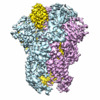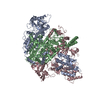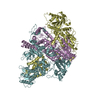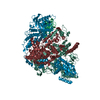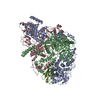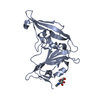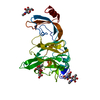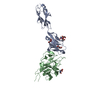[English] 日本語
 Yorodumi
Yorodumi- EMDB-6526: Cryo-electron microscopy structure of a coronavirus spike glycopr... -
+ Open data
Open data
- Basic information
Basic information
| Entry | Database: EMDB / ID: EMD-6526 | |||||||||
|---|---|---|---|---|---|---|---|---|---|---|
| Title | Cryo-electron microscopy structure of a coronavirus spike glycoprotein trimer | |||||||||
 Map data Map data | Reconstruction of a furin cleavage site mutant | |||||||||
 Sample Sample |
| |||||||||
 Keywords Keywords |  Coronavirus / viral fusion proteins / Coronavirus / viral fusion proteins /  viral spike / viral spike /  peplomer peplomer | |||||||||
| Function / homology |  Function and homology information Function and homology informationendocytosis involved in viral entry into host cell / host cell Golgi apparatus / host cell endoplasmic reticulum-Golgi intermediate compartment membrane / receptor-mediated virion attachment to host cell / fusion of virus membrane with host plasma membrane / fusion of virus membrane with host endosome membrane /  viral envelope / host cell plasma membrane / virion membrane / viral envelope / host cell plasma membrane / virion membrane /  membrane / identical protein binding membrane / identical protein bindingSimilarity search - Function | |||||||||
| Biological species |   Murine hepatitis virus Murine hepatitis virus | |||||||||
| Method |  single particle reconstruction / single particle reconstruction /  cryo EM / Resolution: 4.0 Å cryo EM / Resolution: 4.0 Å | |||||||||
 Authors Authors | Walls AC / Tortorici MA / Bosch BJ / Frenz BJ / Rottier PJM / DiMaio F / Rey FA / Veesler D | |||||||||
 Citation Citation |  Journal: Nature / Year: 2016 Journal: Nature / Year: 2016Title: Cryo-electron microscopy structure of a coronavirus spike glycoprotein trimer. Authors: Alexandra C Walls / M Alejandra Tortorici / Berend-Jan Bosch / Brandon Frenz / Peter J M Rottier / Frank DiMaio / Félix A Rey / David Veesler /    Abstract: The tremendous pandemic potential of coronaviruses was demonstrated twice in the past few decades by two global outbreaks of deadly pneumonia. Entry of coronaviruses into cells is mediated by the ...The tremendous pandemic potential of coronaviruses was demonstrated twice in the past few decades by two global outbreaks of deadly pneumonia. Entry of coronaviruses into cells is mediated by the transmembrane spike glycoprotein S, which forms a trimer carrying receptor-binding and membrane fusion functions. S also contains the principal antigenic determinants and is the target of neutralizing antibodies. Here we present the structure of a mouse coronavirus S trimer ectodomain determined at 4.0 Å resolution by single particle cryo-electron microscopy. It reveals the metastable pre-fusion architecture of S and highlights key interactions stabilizing it. The structure shares a common core with paramyxovirus F proteins, implicating mechanistic similarities and an evolutionary connection between these viral fusion proteins. The accessibility of the highly conserved fusion peptide at the periphery of the trimer indicates potential vaccinology strategies to elicit broadly neutralizing antibodies against coronaviruses. Finally, comparison with crystal structures of human coronavirus S domains allows rationalization of the molecular basis for species specificity based on the use of spatially contiguous but distinct domains. | |||||||||
| History |
|
- Structure visualization
Structure visualization
| Movie |
 Movie viewer Movie viewer |
|---|---|
| Structure viewer | EM map:  SurfView SurfView Molmil Molmil Jmol/JSmol Jmol/JSmol |
| Supplemental images |
- Downloads & links
Downloads & links
-EMDB archive
| Map data |  emd_6526.map.gz emd_6526.map.gz | 8.3 MB |  EMDB map data format EMDB map data format | |
|---|---|---|---|---|
| Header (meta data) |  emd-6526-v30.xml emd-6526-v30.xml emd-6526.xml emd-6526.xml | 11 KB 11 KB | Display Display |  EMDB header EMDB header |
| Images |  400_6526.gif 400_6526.gif 80_6526.gif 80_6526.gif | 81.9 KB 4.9 KB | ||
| Archive directory |  http://ftp.pdbj.org/pub/emdb/structures/EMD-6526 http://ftp.pdbj.org/pub/emdb/structures/EMD-6526 ftp://ftp.pdbj.org/pub/emdb/structures/EMD-6526 ftp://ftp.pdbj.org/pub/emdb/structures/EMD-6526 | HTTPS FTP |
-Related structure data
| Related structure data |  3jclMC M: atomic model generated by this map C: citing same article ( |
|---|---|
| Similar structure data |
- Links
Links
| EMDB pages |  EMDB (EBI/PDBe) / EMDB (EBI/PDBe) /  EMDataResource EMDataResource |
|---|
- Map
Map
| File |  Download / File: emd_6526.map.gz / Format: CCP4 / Size: 89 MB / Type: IMAGE STORED AS FLOATING POINT NUMBER (4 BYTES) Download / File: emd_6526.map.gz / Format: CCP4 / Size: 89 MB / Type: IMAGE STORED AS FLOATING POINT NUMBER (4 BYTES) | ||||||||||||||||||||||||||||||||||||||||||||||||||||||||||||||||||||
|---|---|---|---|---|---|---|---|---|---|---|---|---|---|---|---|---|---|---|---|---|---|---|---|---|---|---|---|---|---|---|---|---|---|---|---|---|---|---|---|---|---|---|---|---|---|---|---|---|---|---|---|---|---|---|---|---|---|---|---|---|---|---|---|---|---|---|---|---|---|
| Annotation | Reconstruction of a furin cleavage site mutant | ||||||||||||||||||||||||||||||||||||||||||||||||||||||||||||||||||||
| Voxel size | X=Y=Z: 1.46 Å | ||||||||||||||||||||||||||||||||||||||||||||||||||||||||||||||||||||
| Density |
| ||||||||||||||||||||||||||||||||||||||||||||||||||||||||||||||||||||
| Symmetry | Space group: 1 | ||||||||||||||||||||||||||||||||||||||||||||||||||||||||||||||||||||
| Details | EMDB XML:
CCP4 map header:
| ||||||||||||||||||||||||||||||||||||||||||||||||||||||||||||||||||||
-Supplemental data
- Sample components
Sample components
-Entire : Murine hepatitis virus protein S
| Entire | Name: Murine hepatitis virus protein S |
|---|---|
| Components |
|
-Supramolecule #1000: Murine hepatitis virus protein S
| Supramolecule | Name: Murine hepatitis virus protein S / type: sample / ID: 1000 / Oligomeric state: Trimer / Number unique components: 1 |
|---|---|
| Molecular weight | Theoretical: 420 KDa |
-Macromolecule #1: Murine hepatitis virus protein S
| Macromolecule | Name: Murine hepatitis virus protein S / type: protein_or_peptide / ID: 1 / Oligomeric state: Trimer / Recombinant expression: Yes |
|---|---|
| Source (natural) | Organism:   Murine hepatitis virus / Strain: A59 / synonym: MHV Murine hepatitis virus / Strain: A59 / synonym: MHV |
| Molecular weight | Theoretical: 140 KDa |
| Recombinant expression | Organism:   Drosophila melanogaster (fruit fly) / Recombinant cell: S2 Drosophila melanogaster (fruit fly) / Recombinant cell: S2 |
| Sequence | UniProtKB:  Spike glycoprotein Spike glycoprotein |
-Experimental details
-Structure determination
| Method |  cryo EM cryo EM |
|---|---|
 Processing Processing |  single particle reconstruction single particle reconstruction |
| Aggregation state | particle |
- Sample preparation
Sample preparation
| Concentration | 1.85 mg/mL |
|---|---|
| Buffer | pH: 7.5 / Details: 20 mM Tris-HCl, 100 mM NaCl |
| Vitrification | Cryogen name: ETHANE / Chamber humidity: 90 % / Chamber temperature: 93 K / Instrument: GATAN CRYOPLUNGE 3 / Method: Blot for 3.5 seconds before plunging |
- Electron microscopy
Electron microscopy
| Microscope | FEI TITAN KRIOS |
|---|---|
| Electron beam | Acceleration voltage: 300 kV / Electron source:  FIELD EMISSION GUN FIELD EMISSION GUN |
| Electron optics | Calibrated magnification: 38022 / Illumination mode: FLOOD BEAM / Imaging mode: BRIGHT FIELD Bright-field microscopy / Cs: 2.7 mm / Nominal defocus max: 5.0 µm / Nominal defocus min: 2.0 µm / Nominal magnification: 22500 Bright-field microscopy / Cs: 2.7 mm / Nominal defocus max: 5.0 µm / Nominal defocus min: 2.0 µm / Nominal magnification: 22500 |
| Sample stage | Specimen holder model: FEI TITAN KRIOS AUTOGRID HOLDER |
| Date | Dec 9, 2014 |
| Image recording | Category: CCD / Film or detector model: GATAN K2 SUMMIT (4k x 4k) / Number real images: 1600 / Average electron dose: 53 e/Å2 Details: Every image is the average of 38 frames recorded by the direct electron detector. |
| Experimental equipment |  Model: Titan Krios / Image courtesy: FEI Company |
- Image processing
Image processing
| CTF correction | Details: Each particle |
|---|---|
| Final reconstruction | Algorithm: OTHER / Resolution.type: BY AUTHOR / Resolution: 4.0 Å / Resolution method: OTHER / Software - Name: Relion / Number images used: 82000 |
-Atomic model buiding 1
| Initial model | PDB ID: |
|---|---|
| Software | Name: Rosetta, Coot, Chimera |
| Refinement | Space: REAL / Protocol: FLEXIBLE FIT |
| Output model |  PDB-3jcl: |
-Atomic model buiding 2
| Initial model | PDB ID: |
|---|---|
| Software | Name: Rosetta, Coot, Chimera |
| Refinement | Space: REAL / Protocol: FLEXIBLE FIT |
| Output model |  PDB-3jcl: |
 Movie
Movie Controller
Controller


